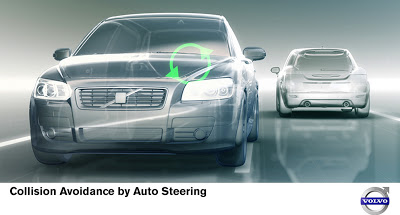Swedish carmaker Volvo is showcasing a new generation of protective safety systems that promise to help improve road safety. The systems that Volvo’s engineers are currently developing are the Collision Warning with Auto Brake for pedestrians, Collision Avoidance by Auto Steering and Vehicle to Vehicle Communication.“Today we need to focus on technologies that predict and prevent accidents from even occurring. It is important to understand that collisions are not inevitable. Preventive Safety is all about helping and supporting the driver to avoid accidents,” says Jonas Ekmark, Manager for Preventive Safety at Volvo Cars Safety Centre. -Details after the jump
FUTURE TECHNOLOGY FROM VOLVO TO IMPROVE ROAD SAFETY
- Automatic braking to avoid pedestrians
- Automatic steering to stop head-on collisions
- Communication between cars to reduce traffic pile-ups
The Volvo that sees peopleDeveloping Volvo’s newly-introduced Collision Warning with Auto Brake (for detecting vehicle to vehicle collisions) further, this future system will assist the human eye and help the driver to ‘see’ people. It uses radar technology with a wide-angle search area to detect objects in front of and around the car.
If the car approaches a pedestrian, a red warning light will come on first on the windscreen’s head-up display and a warning signal will sound. This helps the driver to react and, in most cases, an accident can be avoided.
If the risk of a collision increases further, assisted panic braking is activated to provide more pressure when the brakes are applied and if the driver still doesn’t brake, and the collision is imminent, the car’s brakes are activated automatically.
The automatic braking has the capacity to reduce the car’s speed by approximately 15mph. Depending on the situation and the car’s speed this may mean in certain cases that a collision cannot be completely avoided.Steer away from dangerCollision Avoidance by Auto Steering is a further development of Lane Departure Warning, which uses a camera to monitor the car’s position between lane markers. If a car wanders across any of the lane markers without using the indicator, the driver is warned by an audible signal.
Collision Avoidance by Auto Steering is significantly more advanced. The system is designed to help prevent a frontal collision caused by temporary distraction by using both a camera and radar to monitor the position of the car itself and the oncoming traffic.
If the car is about to move into the wrong lane and the system detects that an oncoming vehicle is on a collision course, the car is automatically steered back to a safe position in the original lane. The high demands for reliability mean that Volvo experts are still assessing which degrees of steering wheel intervention are relevant and the exact speed range the system can operate within.
Talk to each otherVolvo research shows that cars that can communicate with other vehicles and the surrounding traffic environment can enhance the potential for safer driving and fewer traffic accidents.
Volvo has a number of test vehicles that can communicate with each other. For example, a driver in one car can receive information that another car further ahead on the same road, or around a blind corner, has come across an obstacle and has slammed on the brakes – and this makes it possible to brake in good time. However, for communication to work, it is necessary to have a standard “language” so that all vehicles can talk to each other irrespective of make or model.
“With communication between vehicles, and between vehicles and the traffic environment, a large number of today’s accidents could be avoided. The major challenges are to find a standard “language” and the particular applications that are most urgent and effective,” says Jonas Ekmark.









